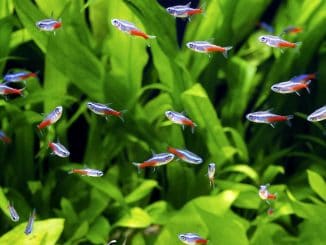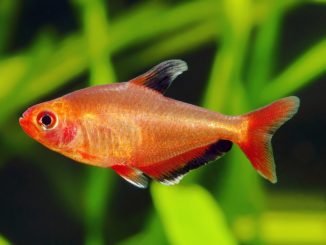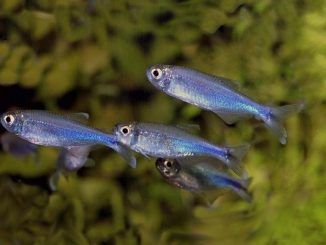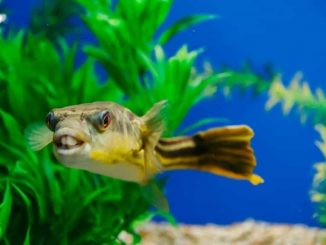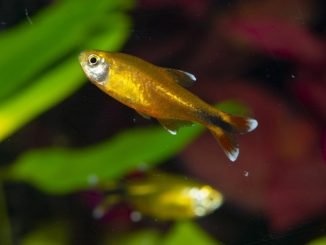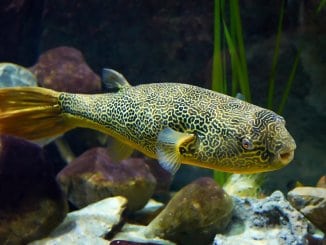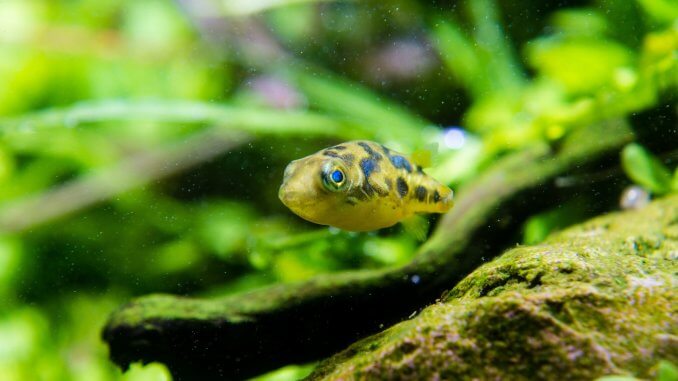
The pea puffer is a small and intelligent freshwater fish that is sure to make a great addition to any tank.
Native to India, the pea puffer is one of the smallest, most unique pufferfish in the world.
Due to their small size and tendency to eat live snails, pea puffers have become popular among fishkeepers and aquarists in recent years. However, this popularity has led to their classification as a vulnerable, threatened species, as most specimens are caught in the wild.
TABLE OF CONTENTS
Pea Puffer Facts & Overview
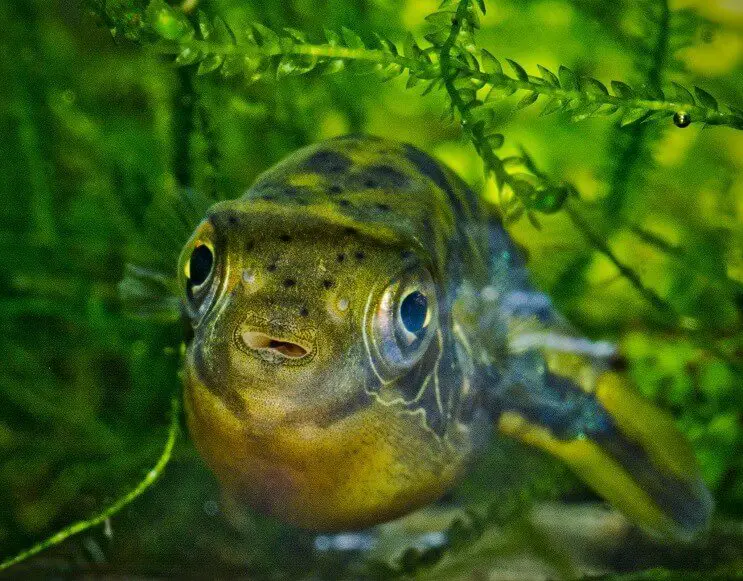
| Category | Rating |
| Care Level: | Intermediate |
| Temperament: | Territorial and aggressive |
| Color Form: | Sex dependent but predominantly yellow |
| Lifespan: | 4 years |
| Size: | 1.4 inches |
| Diet: | Carnivore |
| Family: | Tetraodontiformes |
| Minimum Tank Size: | 5 gallons |
| Tank Set-Up: | Heavily planted |
| Compatibility: | Tropical freshwater |
The Pea Puffer (Carinotetraodon travancoricus) also goes by a few other names including the Dwarf Pufferfish, Pea Puffer Fish, Pygmy Pufferfish, Dwarf Pea Puffer, and the Malabar Pufferfish.
It gets these names because of its size – it is one of the smallest members of its family, growing to a maximum size of 1.4 inches.
Their small size and lifespan of up to 4 years amongst other factors have caused the popularity of this species to soar over the past few decades.
Unfortunately, this has resulted in wild-caught specimens being captured and has caused this species to be listed as vulnerable to extinction. That is why it’s important to try and source your fish from a reputable place that breeds them in captivity.
These fish can be purchased for a relatively cheap price of around $4 per fish.
We recommend purchasing from a local fish store as this gives you the opportunity to select healthier individuals.
These fish are truly fascinating little creatures, which as well as being able to change their color, Pea Puffer Fish are also capable of using their eyes independently of one another.
Typical Behavior
Male Pea Puffer Fish can be very territorial and aggressive towards each other which is why it is really important that when keeping these fish, you keep a single male and several females.
This will reduce aggressive behavior as well as encourage breeding.
Unlike many species of Tetraodontiformes which are solitary fish, Pufferfish are actually social species that are found in large shoals.
They occupy all regions of the tank and can be found in and amongst plant life as well as out in the open scavenging for food. These fish are inquisitive and pay close attention to their surroundings within the tank as well as what you are doing outside of it.
Appearance
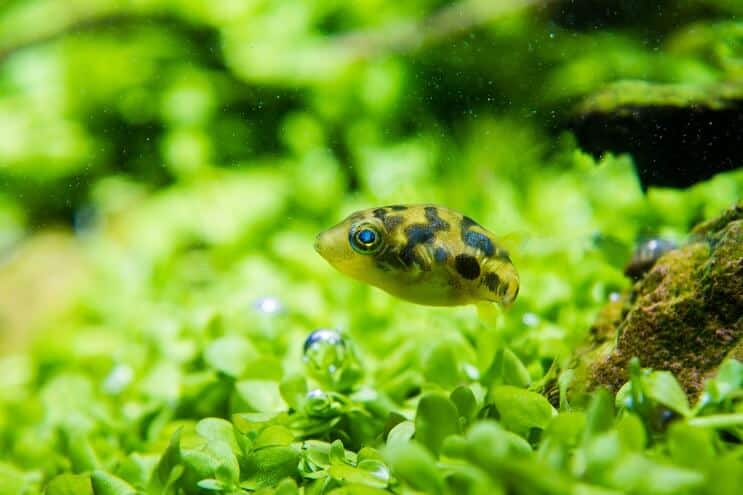
Dwarf Pea Puffers were given their name due to their exceptionally small size. They grow to a maximum length of 1.4 inches which makes them one of the smallest Pufferfish species on the planet.
They are both round in the body and thin towards the back end of the dorsal and anal fins. When looking at them you will notice their particularly large eyes for their small body size.
Males and females differ in appearance which makes them relatively easy to sex. Males have a bright yellow belly compared to the lighter yellow-white bellies of females. Males also possess a dark stripe on their belly which the females do not have. Males are typically a darker golden-green coloration where females are a lighter yellow-green.
Both males and females have dark patches on the upper side of the body, however, males have a thick dark stripe that runs from the pectoral fins to the caudal fin and females have random tiny black spots across their bodies.
Males also have wrinkles around their eyes.
Habitat and Tank Requirements
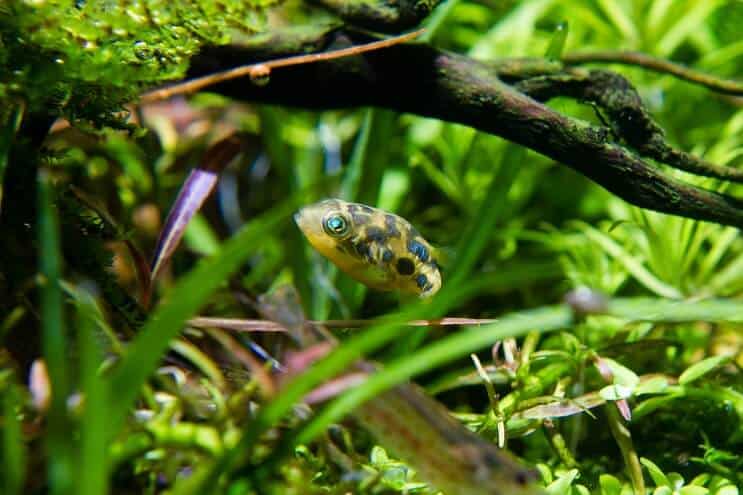
The Dwarf Puffer comes from rivers, lakes, and estuaries in Southwest India. The conditions of the water vary between each body of water with a pH ranging from 6.5-8.5 and an average water temperature of 77°F. However, some parts have been known to reach 92°F.
These fish are sometimes found in the slightly brackish waters of estuaries – however, they are not brackish water fish and should not be kept in such conditions in your home aquaria as this will reduce their life expectancy.
Their home range receives around 12 hours of sunlight throughout the summer months and is reduced to around 10.5 hours during the winter months.
These fish prefer to occupy slow-flowing areas of rivers and still lake waters in banks where there is plenty of plant life to shelter them from the flow of the water as well as predation.
It is in these heavily planted areas where these intelligent little hunters do the majority of their feeding as well as their breeding.
Tank Setup
Within your aquarium, you should aim to keep these fish in freshwater with a temperature of 77-79°F – the pH of the water should be maintained between 6.5 and 7.0.
If you are using a filter with an adjustable outlet for water, then point it towards the back of the tank to keep the water flow to a minimum.
The substrate should be either coarse sand or small particle gravel which will allow room for plant roots to spread.
When it comes to plants, the more you include the better as it will provide a more naturalistic feel for the fish and will encourage breeding behavior as well as providing plenty of dissolved oxygen to help your fish breathe.
Plants like Anubias Nana, Stargrass, Cabomba, and Java Moss are all great options and there are many more to choose from.
You may want to purchase some long aquascape tweezers and scissors for maintaining and planting new plants when your fish are already in the tank to prevent being bitten by their razor-sharp beaks.
Pea Puffer Tank Size?
The minimum size of aquarium recommended for a Dwarf Puffer is a 5-gallon tank.
A breeding setup should be 20 gallons which will provide plenty of space for one male to be housed with 3 females.
For every 5 gallons of water your aquarium holds, you should only house one Pea Puffer.
Tank Mates
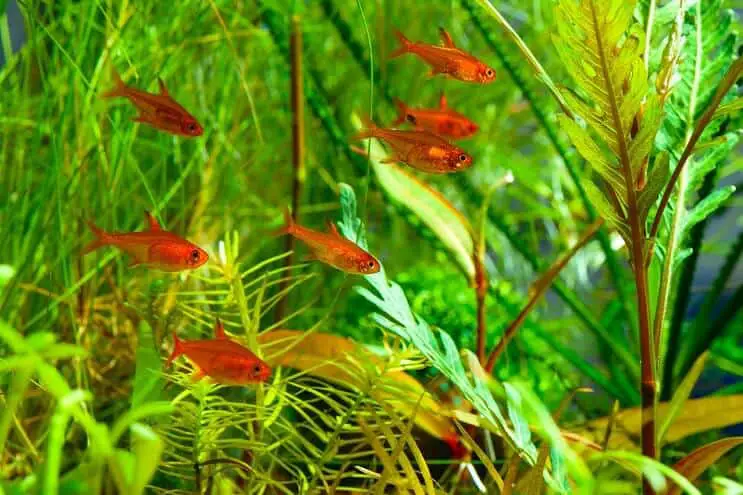
In the wild, this species can be found in river systems with other freshwater fish fauna like Filament Barbs, Long-finned Barbs, Paral Fish, Malabar Leaf Fish, and Orange Chromide.
So whilst it is possible to keep them in a community tank, we recommend keeping them in a species-only aquarium due to their territorial and aggressive behavior towards other fish (which usually results in fin nipping).
If you do choose to keep them in community tanks then be sure to keep them with small fast-swimming species like Ember Tetras, Neon Tetras, Glowlight Tetra, Filament Barb, Mosquito Rasbora, Zebra Danio, Leopard Danio, Harlequin Rasbora, Dwarf Otocinclus, or Siamese Algae Eaters.
We do not advise that you do keep them with other species, however, if you were to do this then be sure to have a separate tank set up in case they do need to be separated from one another for antibiotic wound treatment because of nips.
Placing these voracious little predators in with your prized shrimp collections is also not advised, as these creatures are active hunters and will eat any small shrimp species, such as cherry shrimp, they come across.
Any small snail species like Bladder Snails or Malaysian Trumpet Snails for example are also vulnerable to predation.
Avoid keeping these miniature Puffer Fish with any predatory species like large Catfish or with any slow-moving and long-finned fish like Guppies which will almost certainly get their fins nipped.
Can You Keep Pea Puffers Together?
It is highly advised that males be housed separately from each other as they can become territorial and aggressive towards one another, especially during breeding.
A single male should be housed with multiple females which will not only provide them with a more relaxing environment but will also increase your chances of mating success.
Diet
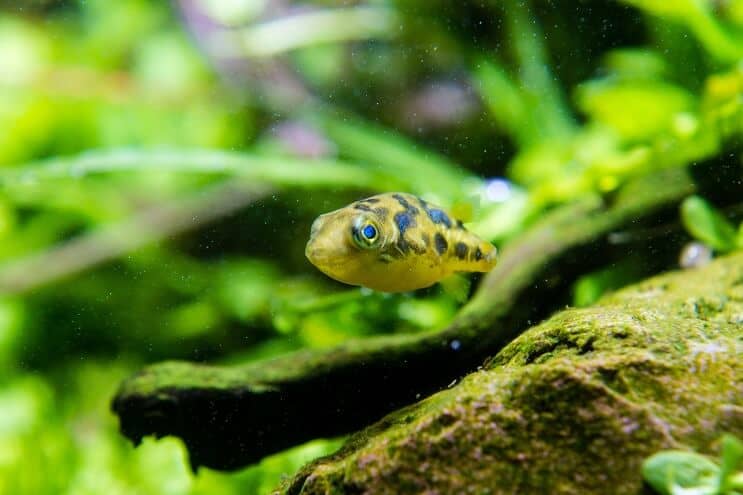
In their natural habitat, Pea Puffer Fish feed on small amounts of microscopic algae, insects, larvae, copepods, and water fleas.
Within an aquarium, try to feed a diet of live and frozen foods such as bloodworms, brine shrimp, cyclops, small shrimps, and snails. The occasional algae wafer could also be added but they may not be eaten.
Try to feed your Dwarf Pufferfish twice a day, preferably in the morning and evening. They are very intelligent fish and will soon recognize you entering the room which can signal to them that they are about to be fed.
They may appear to be hungry but stick to an amount of food they can consume within three minutes of being placed into the tank to avoid over-feeding them.
Overfeeding can lead to spikes in the nitrate levels of the aquarium which can consequently cause unwanted algae growth within your tank – plants will absorb nitrates as it is one of many essential nutrients.
A good way to keep the tank clean would be to either purchase or make a small coconut feeding bowl. This can be placed at the bottom of the aquarium and you can use long tweezers to place the food inside to avoid getting your hands and fingers nipped.
Care
Dwarf Puffers are known for nipping and being aggressive towards one another, so it’s only a matter of time until injuries occur.
This is why you should keep males separate.
Accidentally placing more than one male in your aquarium can lead to them fighting and small chunks of flesh being taken out of them which provides the ideal location for bacterial or fungal infections.
Firstly, try to avoid this situation happening by doing your research on how to sex these fish (read the appearance section above). Any injured fish should immediately be placed in a separate tank for the correct antibacterial and antifungal treatment.
As with most tropical fish, when temperature levels within the aquarium drop this can cause the fish’s immune system to also drop which leaves them prone to diseases like the Ich infection (more commonly referred to as white spot disease).
Infections are quite hard to identify at first.
White spot treatments are available in most if not all local fish stores and can even be purchased online. The best treatments to use for Ich are any which have a copper sulphate or formalin base.
Because Dwarf Pufferfish are such messy eaters, it is essential to perform weekly gravel cleans to remove any leftover food or parasitic spores using a gravel vacuum.
Garlic-infused products may also be added to the aquarium as this will not only promote a healthy immune system but also encourage feeding.
This is important for newly purchased pufferfish. Wild-caught specimens often refuse to eat when first placed in a tank, because they had a long and stressful journey.
As previously mentioned though, avoid purchasing wild-caught fish for the good of this species.
Breeding
Breeding Dwarf Puffer Fish is relatively easy, providing you keep the water temperature at around 79°F. A 5-gallon breeding tank is suitable for one male to be housed with one female however a separate breeding tank is not mandatory as they will breed in your main aquarium.
Heavily planted tanks are a must as males will often chase the females around the tank until she is ready to breed. At this point, the female will lead the male in amongst the plants to spawn. A java moss clump is a perfect habitat to spawn.
You can also use a piece of bogwood to make the aquarium feel more natural as well as provide the ideal habitat for bacteria which are beneficial for the nitrifying bacteria to grow on.
After spawning, the fry will hatch out of their eggs in around 48 hours. Once the fry has completely absorbed their egg yolk (2-3 days after hatching) you should begin feeding a mix of live infusoria and newly hatched brine shrimp to encourage a fast growth rate.
A sponge filter should be placed in the tank so that there is little to no water flow – otherwise, the fry could be sucked into the filter.
Is the Pea Puffer Right For Your Aquarium?
These fish are great fish for beginners and expert fish keepers.
Pufferfish are an intelligent omnivorous species that can be seen actively hunting and foraging throughout all regions of your aquarium.
Due to their territorial and somewhat aggressive behavior, males should not be housed together but instead, single males should be kept with multiple females.
We do not recommend keeping any other fish in the tank with them as they are renowned fin nippers.
These fish are easily bred providing you meet the correct water parameters and fill your tank with lots of plants like Java fern.
Pea Puffer FAQs
- How many pea puffers can you keep in a 10-gallon tank?
- Are pea puffers hardy?
- What kind of water do pea puffers need?
- What do pea puffers eat?
- What size tank do pea puffers need?
- Do pea puffers eat ramshorn snails?
- Do you have to trim a pea puffer's teeth?
- How long do pea puffers live?
- Can pea puffers live with neon tetras?
- Do pea puffers need live plants?
- Can pea puffers live with bettas?
- What fish can live with pea puffers?
- Can a pea puffer live alone?
- Can you keep shrimp with pea puffers?
- Can I touch a pea puffer?
- Is a pea puffer poisonous?

